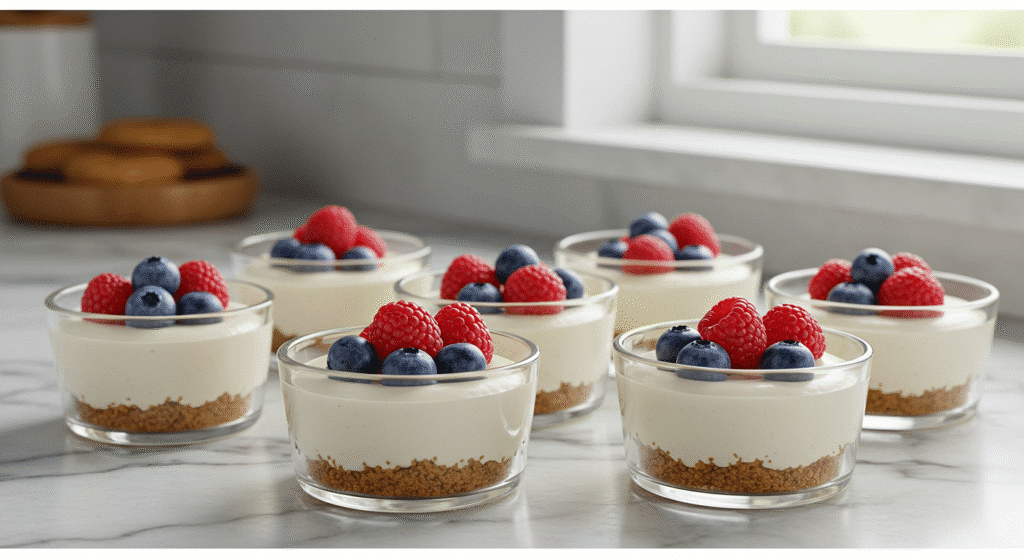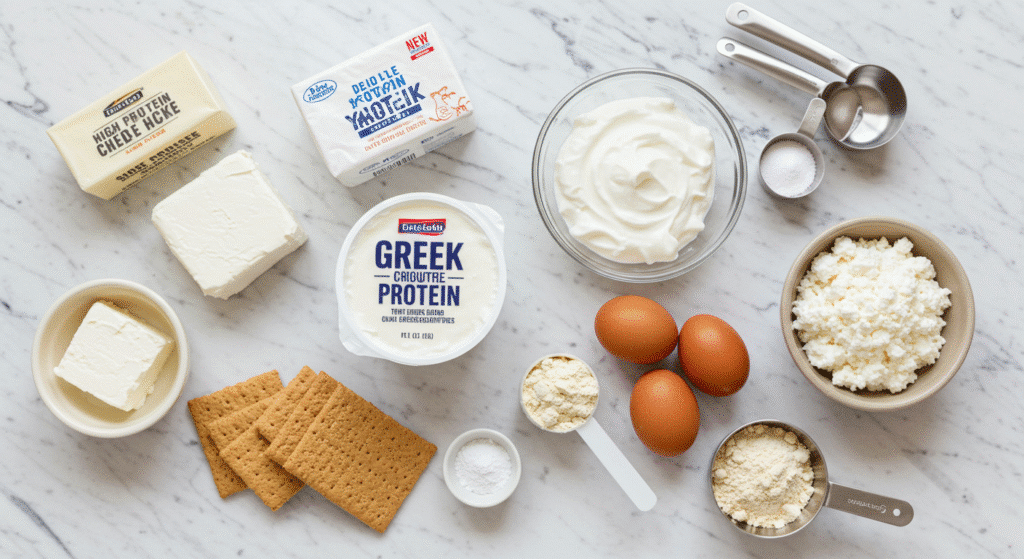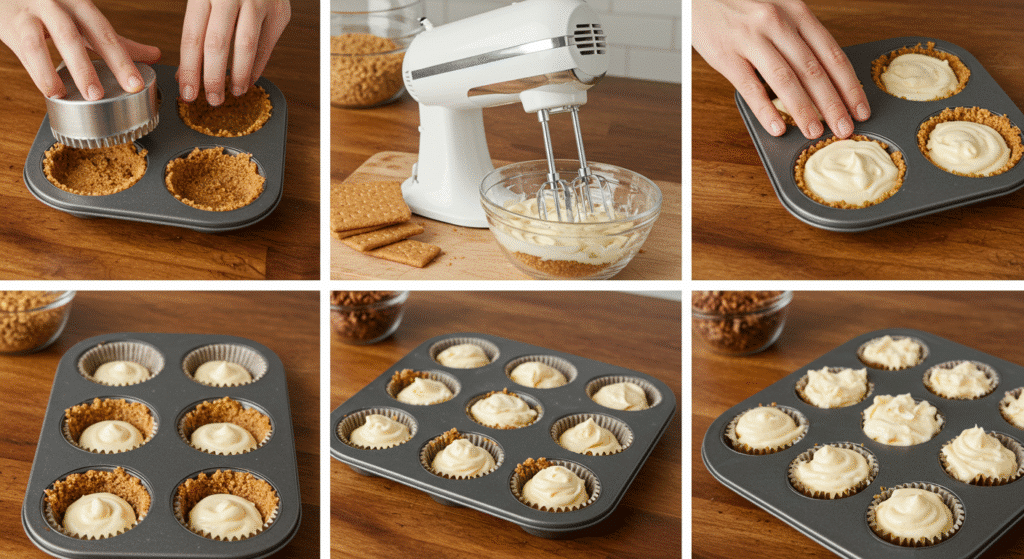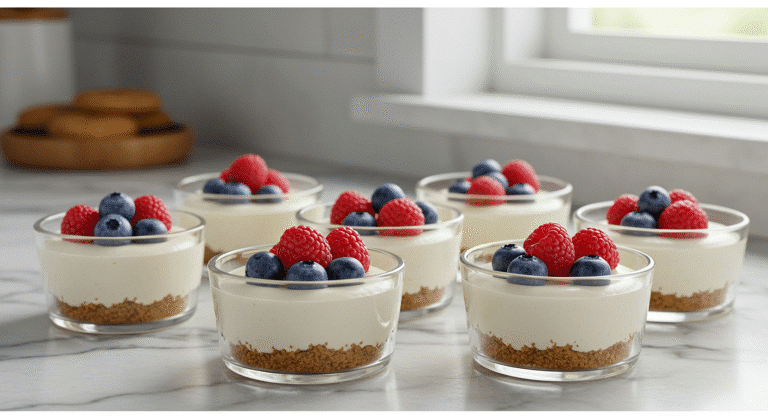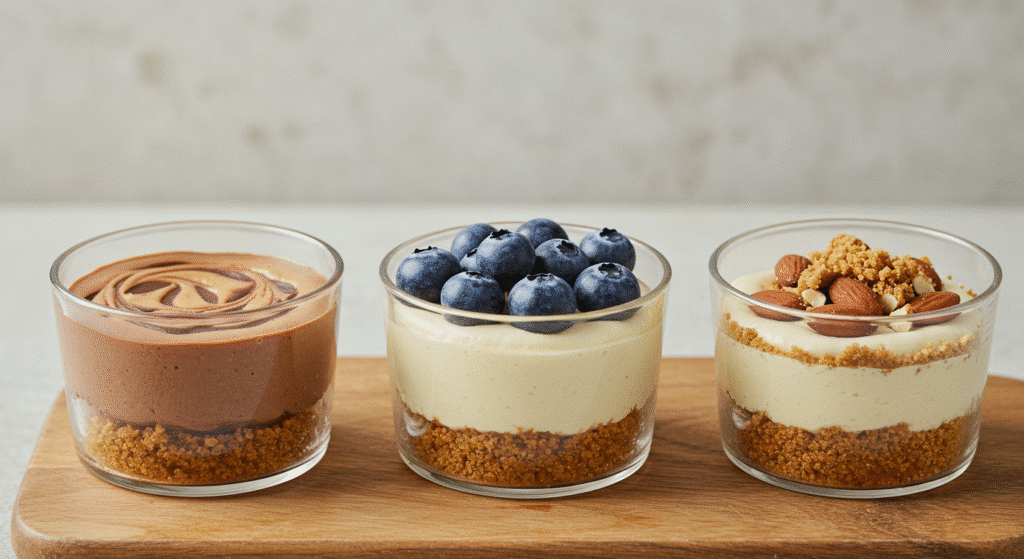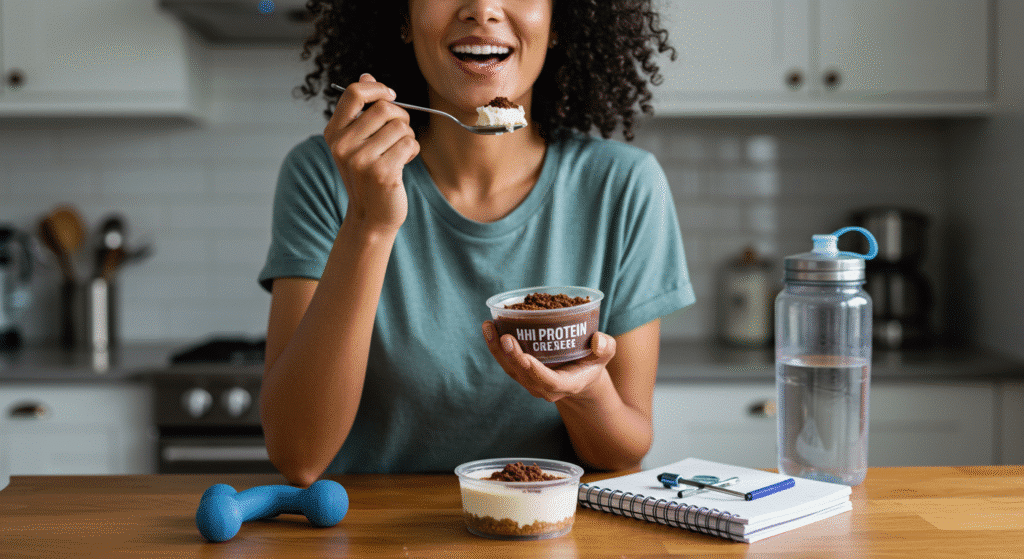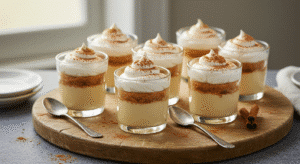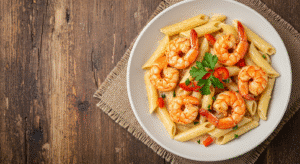High-Protein Cheesecake Cups – Why This Recipe?
As Chef Greeny, I’ve spent countless evenings in my kitchen searching for that perfect dessert that satisfies my sweet tooth without derailing my fitness goals. Last month, after a particularly intense workout session, I found myself craving something creamy and indulgent. That’s when inspiration struck – why not create individual cheesecake portions packed with protein?
These high-protein cheesecake cups represent more than just a dessert; they’re a testament to how we can enjoy life’s pleasures while nourishing our bodies. Each cup delivers approximately 15-18 grams of protein, making them perfect for post-workout recovery or satisfying afternoon cravings without the guilt.
What makes this recipe special is the clever combination of Greek yogurt, cottage cheese, and protein powder, creating a texture so rich and creamy that you’ll forget you’re eating something healthy. Today, you’ll discover my foolproof method for creating these protein-packed treats, plus three creative variations that will keep your taste buds excited.
High-Protein Cheesecake Cups – Ingredients and Preparation
Ingredients List
For the Crust:
- 1 cup graham cracker crumbs (or 1 cup almond flour for gluten-free)
- 3 tablespoons melted butter (or coconut oil for dairy-free)
- 2 tablespoons honey or maple syrup
- 1 tablespoon vanilla protein powder (optional, for extra protein)
For the Filling:
- 16 oz cream cheese, softened (or cashew cream cheese for vegan)
- 1 cup plain Greek yogurt (2% fat)
- ½ cup cottage cheese, blended smooth
- 2 scoops vanilla whey protein powder (about 60g)
- ½ cup powdered erythritol or stevia blend
- 3 large eggs
- 2 teaspoons vanilla extract
- 1 tablespoon lemon juice
- Pinch of salt
For Toppings (Optional):
- Fresh berries
- Sugar-free chocolate chips
- Chopped nuts
- Whipped cream
Step-by-Step Instructions
- Preheat and Prepare: Set your oven to 325°F (163°C). Line a 12-cup muffin tin with paper liners or grease with cooking spray.
- Create the Crust: Mix graham cracker crumbs, melted butter, honey, and protein powder in a bowl. Press 1-2 tablespoons of mixture firmly into each muffin cup. Chef Greeny’s tip: Use the bottom of a small glass to create perfectly even crusts.
- Blend the Filling: In a large bowl, beat softened cream cheese until smooth. Gradually add Greek yogurt and blended cottage cheese, mixing until completely combined. Avoid overmixing to prevent cracks during baking.
- Add Protein and Sweetener: Slowly incorporate protein powder and sweetener, beating on low speed. The key here is patience – rushing this step can create lumps that won’t disappear during baking.
- Incorporate Wet Ingredients: Add eggs one at a time, then vanilla extract, lemon juice, and salt. Mix just until combined. Chef Greeny’s secret: Room temperature ingredients blend more easily and create a smoother texture.
- Fill and Bake: Divide filling evenly among prepared cups, about ¾ full. Bake for 18-22 minutes until centers are almost set but still slightly jiggly.
- Cool Properly: Turn off oven and crack the door open. Let cheesecakes cool in the oven for 30 minutes, then refrigerate for at least 4 hours or overnight.
Notes and Pro Tips
Storage: These high-protein cheesecake cups stay fresh in the refrigerator for up to 5 days. Cover tightly with plastic wrap to prevent them from absorbing other flavors.
Make-Ahead Instructions: Prepare these cups up to 3 days in advance. They actually taste better after sitting overnight as flavors meld together beautifully.
Professional Tip: If you notice cracks forming during baking, place a small oven-safe dish of water on the bottom rack. The steam creates a gentle baking environment that prevents cracking.
Serving Suggestions: Serve chilled with fresh berries, a dollop of whipped cream, or a drizzle of sugar-free caramel sauce. For an extra protein boost, top with chopped almonds or a sprinkle of protein powder.
High-Protein Cheesecake Cups – Nutritional Information
Nutrition Facts (Per Serving)
| Nutrient | Amount (~) |
|---|---|
| Calories | 185 |
| Carbohydrates (g) | 8 |
| Protein (g) | 17 |
| Total Fat (g) | 9 |
| Saturated Fat (g) | 5 |
| Unsaturated Fat (g) | 3 |
| Trans Fat (g) | 0 |
| Fiber (g) | 1 |
| Sugar (g) | 4 |
| Cholesterol (mg) | 75 |
| Sodium (mg) | 220 |
Nutritional values are approximate and based on using standard ingredients. Values may vary depending on specific brands and substitutions used.
Print5 Secrets to Perfect High-Protein Cheesecake Cups That Will Transform Your Dessert Game
These high-protein cheesecake cups are the perfect guilt-free dessert! Made with Greek yogurt, cottage cheese, and protein powder, each individual portion delivers 17 grams of protein. Perfect for post-workout recovery or satisfying sweet cravings without derailing your fitness goals.
- Total Time: 282
- Yield: 12 1x
Ingredients
1 cup graham cracker crumbs (or 1 cup almond flour for gluten-free)
3 tablespoons melted butter (or coconut oil for dairy-free)
2 tablespoons honey or maple syrup
1 tablespoon vanilla protein powder (optional, for extra protein)
16 oz cream cheese, softened (or cashew cream cheese for vegan)
1 cup plain Greek yogurt (2% fat)
½ cup cottage cheese, blended smooth
2 scoops vanilla whey protein powder (about 60g)
½ cup powdered erythritol or stevia blend
3 large eggs
2 teaspoons vanilla extract
1 tablespoon lemon juice
Pinch of salt
Fresh berries for topping (optional)
Sugar-free chocolate chips for topping (optional)
Instructions
1. Preheat oven to 325°F (163°C). Line a 12-cup muffin tin with paper liners or grease with cooking spray.
2. Mix graham cracker crumbs, melted butter, honey, and protein powder in a bowl. Press 1-2 tablespoons of mixture firmly into each muffin cup using the bottom of a small glass.
3. In a large bowl, beat softened cream cheese until smooth. Gradually add Greek yogurt and blended cottage cheese, mixing until completely combined.
4. Slowly incorporate protein powder and sweetener, beating on low speed to avoid lumps.
5. Add eggs one at a time, then vanilla extract, lemon juice, and salt. Mix just until combined – don’t overmix.
6. Divide filling evenly among prepared cups, filling about ¾ full.
7. Bake for 18-22 minutes until centers are almost set but still slightly jiggly.
8. Turn off oven and crack the door open. Let cheesecakes cool in the oven for 30 minutes.
9. Refrigerate for at least 4 hours or overnight before serving.
10. Top with fresh berries or other desired toppings before serving.
Notes
Store covered in refrigerator for up to 5 days.
Can be made up to 3 days in advance – they taste even better after overnight chilling.
For crack-free tops, use room temperature ingredients and avoid overmixing.
Place a dish of water on the bottom oven rack to create steam and prevent cracking.
Freeze individual cups wrapped in plastic wrap for up to 3 months.
For dairy-free version: use cashew cream cheese, coconut Greek yogurt, and silken tofu instead of cottage cheese.
For keto version: substitute almond flour for graham crackers and use monk fruit sweetener.
- Prep Time: 20
- Cook Time: 22
- Category: Dessert
- Method: Baking
- Cuisine: American
Nutrition
- Serving Size: 1
- Calories: 185
- Sugar: 4
- Sodium: 220
- Fat: 9
- Saturated Fat: 5
- Unsaturated Fat: 3
- Trans Fat: 0
- Carbohydrates: 8
- Fiber: 1
- Protein: 17
- Cholesterol: 75
Keywords: high protein cheesecake, protein dessert, healthy cheesecake, individual cheesecake cups, post workout dessert, Greek yogurt cheesecake, cottage cheese dessert, protein powder recipe
High-Protein Cheesecake Cups – History and Cultural Significance
Cheesecake traces its origins back to ancient Greece, where it was served to athletes during the Olympic Games for sustained energy. The Romans later adopted and refined the recipe, spreading it throughout their empire. Modern American-style cheesecake emerged in the 1900s with the invention of cream cheese.
The individual portion concept gained popularity in the 2000s as portion control became increasingly important in health-conscious cooking. Similar protein-rich desserts appear in various cultures: Italian ricotta cheesecakes, German quark-based desserts, and Middle Eastern labneh sweets all share the concept of combining dairy proteins with sweet flavors.
Today’s fitness culture has transformed traditional cheesecake into a functional food that supports muscle recovery and weight management goals, making these high-protein versions particularly relevant for modern lifestyles.
High-Protein Cheesecake Cups – Creative Variations
Chocolate Peanut Butter Variation: Replace vanilla protein powder with chocolate powder and add 2 tablespoons of natural peanut butter to the filling. Swirl in sugar-free chocolate chips before baking for an indulgent twist that still delivers 16 grams of protein per cup.
Berry Vanilla Variation: Fold in ½ cup of fresh blueberries or chopped strawberries into the filling before baking. The natural fruit sugars complement the protein powder while adding antioxidants and fiber. This version works particularly well for those following lower-carb lifestyles.
Keto-Friendly Adaptation: Substitute almond flour for graham crackers in the crust and use powdered monk fruit sweetener instead of honey. Add an extra tablespoon of coconut oil to maintain moisture. This version contains only 4 net carbs per serving while maintaining the same protein content.
High-Protein Cheesecake Cups – Frequently Asked Questions
Can I make these without protein powder?
Yes, you can omit the protein powder, though you’ll reduce the protein content to about 12 grams per cup. Add an extra ¼ cup of Greek yogurt to maintain the creamy texture and consider increasing the cottage cheese portion slightly.
Why did my cheesecakes crack on top?
Cracking typically occurs from temperature shock or overmixing. Always use room temperature ingredients, avoid overbeating after adding eggs, and allow gradual cooling in the turned-off oven with the door cracked open.
Can I freeze these high-protein cheesecake cups?
Absolutely! Wrap individual cups in plastic wrap and freeze for up to 3 months. Thaw overnight in the refrigerator before serving. The texture remains creamy and delicious after freezing.
What’s the best protein powder to use?
Vanilla whey protein works best for flavor and texture, but plant-based proteins like pea or hemp work well too. Avoid chalky or overly sweet protein powders as they can affect the final taste and consistency.
How can I make these dairy-free?
Substitute cream cheese with cashew cream cheese, use coconut Greek yogurt, and replace cottage cheese with silken tofu. The protein content will be slightly lower, but you’ll still get approximately 12-14 grams per serving.
High-Protein Cheesecake Cups – Final Thoughts
These high-protein cheesecake cups prove that healthy eating doesn’t require sacrificing flavor or satisfaction. With 17 grams of protein per serving, they support your fitness goals while satisfying dessert cravings. The individual portions make them perfect for meal prep, portion control, and entertaining guests who want to indulge without overindulging.
The combination of Greek yogurt, cottage cheese, and protein powder creates a dessert that’s not only delicious but also functional – supporting muscle recovery, promoting satiety, and providing sustained energy. Whether you’re following a fitness routine, managing your weight, or simply looking for healthier dessert options, these cups deliver on all fronts.
Tried these High-Protein Cheesecake Cups? Share your favorite variation or creative topping combination in the comments below!
For those interested in the broader context of protein-rich desserts and their role in modern nutrition, the Wikipedia article on protein in nutrition provides excellent background on how protein supports various bodily functions and why incorporating it into desserts can be beneficial for overall health goals.
